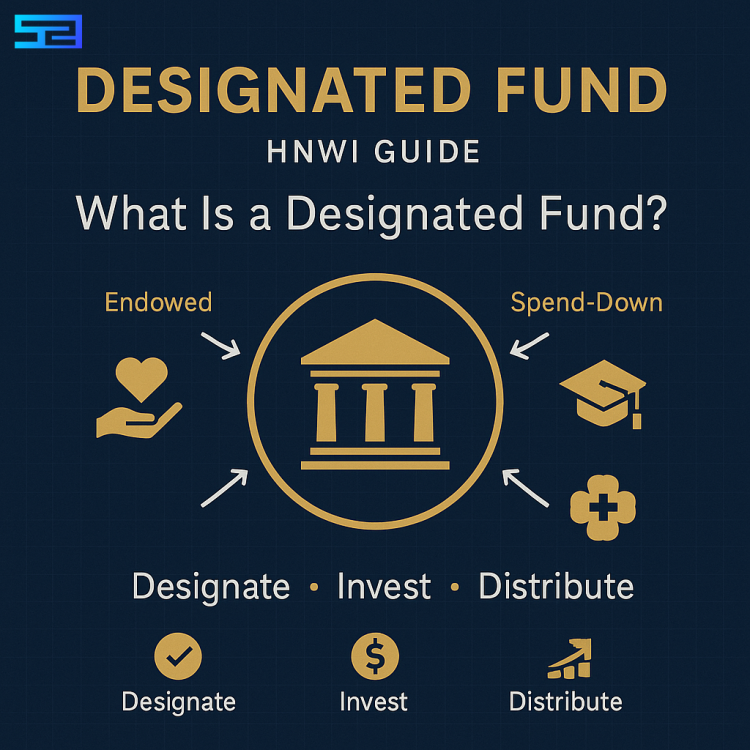What Is a Designated Fund? A Plain-English Guide for HNWI
TL;DR
A designated fund is a charitable fund—typically housed at a community foundation—created by a donor to provide ongoing support to one or more named nonprofit organizations. The donor sets the beneficiary organization(s) at formation; the foundation administers investments and makes grants according to that designation. It’s often used by HNWI seeking predictable, perpetual support without day-to-day grantmaking.
How a Designated Fund Works
Purpose & beneficiaries. At setup, you specify the charity (or a short list of charities) that will receive distributions. After the fund is established, grants flow automatically to those named organizations on a schedule (e.g., quarterly or annually).
Where it’s held. Most designated funds are established at a community foundation or other public charity sponsor. The sponsor handles administration, accounting, and investment management under a board-approved policy.
Endowed vs. non-endowed.
- Endowed: The principal is invested for the long term, and the charity typically receives a policy-based payout (commonly ~4–5% of the fund’s average market value, though policies vary).
- Non-endowed/spend-down: Assets may be granted more flexibly over a set horizon.
Governance & oversight. The sponsor manages the portfolio and executes grants per your written designation. Because beneficiaries are fixed, you don’t retain advisory privileges over grants the way you would with a donor-advised fund.
Designated Fund vs. Donor-Advised Fund vs. Private Foundation
Who controls grants.
- Designated Fund: Grants are pre-committed to named charities.
- DAF: Donor recommends grants over time; the sponsor has final approval.
- Private Foundation: A private board controls grants, operations, and compliance.
Cost & complexity.
- Designated: Streamlined; sponsor fee schedule applies.
- DAF: Streamlined; similar fee ranges to designated funds.
- Private Foundation: Highest complexity; legal, tax filings, governance, and potential excise taxes.
Privacy & reporting.
- Designated/DAF: Administered by a public charity; donor often enjoys more privacy.
- Private Foundation: Public Form 990-PF disclosures (grants, officers, assets).
Best for.
- Designated: You know exactly which charity(ies) you want to support long-term.
- DAF: You value ongoing flexibility in grant selection and timing.
- Private Foundation: You want maximum control, a family governance platform, and are comfortable with complexity.
Quick Comparison Table
| Feature | Designated Fund | Donor-Advised Fund | Private Foundation | Field-of-Interest Fund |
|---|---|---|---|---|
| Grant Control | Fixed to named charity(ies) | Donor recommends | Board decides | Restricted to a cause area |
| QCD Eligibility* | Generally eligible (no advisory privileges) | Not eligible | Not eligible | Often eligible |
| Setup/Complexity | Low | Low | High | Low |
| Privacy | High | High | Lower (public filings) | High |
| Best For | Perpetual support to specific orgs | Flexible giving over time | Control & legacy governance | Support a defined cause |
*The IRS says Qualified Charitable Distributions (QCDs) from IRAs cannot go to donor-advised funds. Community-foundation designated funds may qualify when they are not donor-advised and meet public-charity requirements. Confirm with your sponsor and CPA.
Tax & Regulatory Considerations for HNWI
Deductibility & AGI limits. Contributions to a designated fund at a public charity are generally subject to public-charity deduction limits (cash and appreciated property limits vary by year and filer). The IRS explains these limits in its charitable contributions guidance; talk with your CPA to apply them to your situation.
QCDs from IRAs. The IRS states that QCDs (available at or after the applicable age) can be directed to qualifying public charities but not to donor-advised funds. Designated funds that lack advisory privileges are commonly used as QCD destinations when the sponsor confirms eligibility.
Funding assets. Sponsors typically accept cash or appreciated assets (public equities are most common; some sponsors accept closely held business interests or real estate subject to due diligence and policy).
International giving. If your designated beneficiary is a U.S. charity, cross-border issues are simplified. If you intend to support non-U.S. organizations, discuss compliance pathways with the sponsor.
Not tax, legal, or investment advice. Complex rules apply and change over time. Consult your CPA/attorney.
Implementation Playbook (Step-by-Step)
- Select sponsor & structure. Choose a community foundation or public-charity sponsor; decide endowed vs. spend-down.
- Name beneficiaries. Specify the organization(s) and the distribution formula (e.g., percentage payout, fixed amount, or policy-based spend).
- Fund the vehicle. Transfer cash, appreciated securities, or other assets per sponsor policy; if using QCDs, confirm eligibility.
- Set legacy instructions. Document what happens if a named charity ceases operations or changes mission (“variance power” provisions).
- Review annually. Confirm investment pool selection, payout sufficiency, and beneficiary status.
FAQs
Is a designated fund the same as a donor-advised fund?
No. With a designated fund, beneficiaries are fixed at creation and the sponsor makes grants accordingly. A donor-advised fund preserves ongoing recommendation privileges for the donor.
Can I name more than one charity?
Yes—many HNWI designate two to five organizations and set a percentage split (e.g., 50/30/20) to simplify ongoing support.
Does an endowed designated fund protect principal?
Endowments are invested for long-term support with a policy payout (often ~4–5%); principal values will fluctuate with markets and are not guaranteed.
Can I change beneficiaries later?
The defining feature is pre-designation, so changes are limited. Some sponsors allow changes only under specified conditions (e.g., if a charity dissolves or no longer meets the stated purpose).
Editorial Standards
About the author. This guide is written for sophisticated donors and family offices in the spirit of StephenTwomey.com’s investor-focused content. Stephen Twomey is an accredited investor and entrepreneur who writes about alternative vehicles, private placements, and philanthropic structuring for HNWI audiences.
Methodology & sources. This article reflects common practices described by community foundations, national DAF sponsors, and the IRS (e.g., IRS charitable contribution rules and QCD guidance). Specific sponsor policies and IRS thresholds change; verify with your CPA/attorney and the fund sponsor before acting. Learn about investing in an SDIRA with/ Forex.
Review cadence. Content is reviewed periodically for tax/regulatory updates and sponsor policy changes that could affect eligibility, payout, or deductibility.





